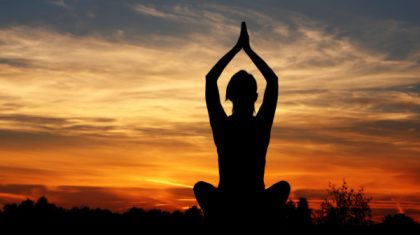Surya Namaskar, also known as Sun Salutation, is a sequence of yoga poses traditionally performed in the early morning to greet the sun and awaken the body, mind, and spirit. This practice is rooted in Indian yoga and has gained popularity worldwide due to its numerous physical, mental, and spiritual benefits. Surya Namaskar is often used as a warm-up or standalone practice in yoga routines.

How To Practise Surya Namaskar?
The Surya Namaskar typically consists of 12 poses. Each pose coordinates with a specific breath, creating a rhythmic and meditative movement. While variations can exist, a common version of Surya Namaskar includes:
- Pranamasana (Prayer Pose): Stand at the front of your mat with hands in a prayer position at your chest. This pose represents gratitude and setting an intention.
- Hasta Uttanasana (Raised Arms Pose): Inhale, lift your arms, and arch your back gently, stretching your body upwards.
- Hasta Padasana (Hand to Foot Pose): Exhale, bend at the hips, and bring your hands down to the floor beside your feet. Try to keep your spine straight.
- Ashwa Sanchalanasana (Equestrian Pose): Inhale, step your right foot back into a lunge, while keeping your left knee bent and aligned over your left ankle.
- Dandasana (Stick Pose): As you exhale, step your left foot back to join your right foot. Your body should be in a straight line like a plank.
- Ashtanga Namaskar (Eight-Limbed Pose): Lower your knees, chest, and chin to the floor while keeping your hips slightly lifted. This is a modified low plank pose.
- Bhujangasana (Cobra Pose): Inhale, glide forward and upward into a gentle backbend, keeping your hands beneath your shoulders.
- Adho Mukha Svanasana (Downward-Facing Dog Pose): Exhale, lift your hips and push back into an inverted “V” shape, grounding your palms and heels.
- Ashwa Sanchalanasana (Equestrian Pose): Inhale, step your right foot forward between your hands in a lunge.
- Hasta Padasana (Hand to Foot Pose): Exhale, bring your left foot forward to meet your right foot, folding at the hips.
- Hasta Uttanasana (Raised Arms Pose): Inhale, rise up with your arms extended and arch your back slightly.
- Pranamasana (Prayer Pose): Exhale, return to the starting position with your hands in prayer at your chest.
Performing multiple rounds of Surya Namaskar can provide various benefits, including increased flexibility, improved circulation, enhanced respiratory function, and a sense of calm and mental clarity. It’s essential to listen to your body and adjust the practice to your comfort level, especially if you’re new to yoga or have any physical limitations.




